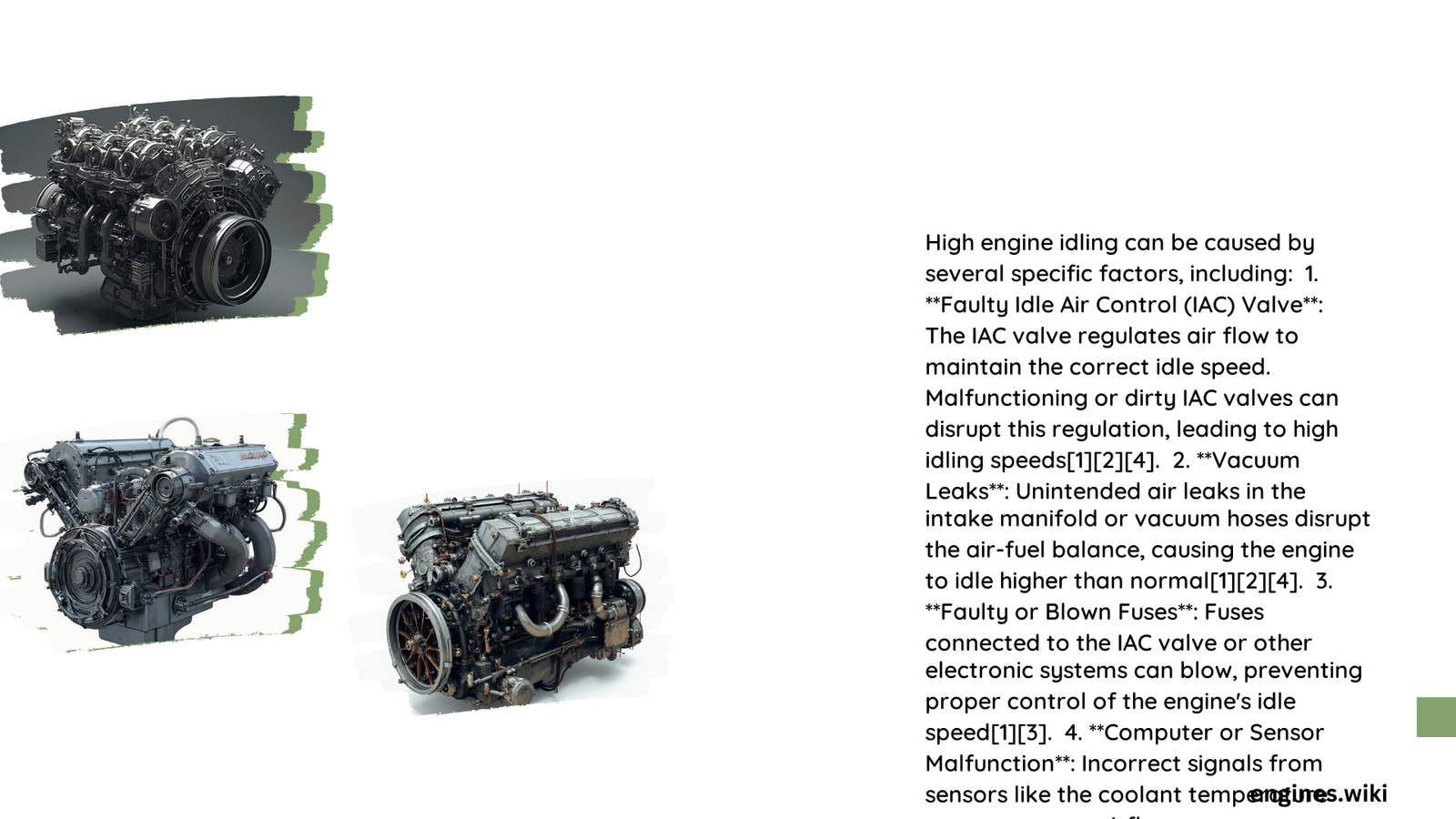An engine idling high can be caused by various factors, including sensor malfunctions, vacuum leaks, and component failures. Common culprits include a faulty throttle position sensor, vacuum leaks, idle air control valve issues, and mass airflow sensor inaccuracies. These problems can disrupt the air-fuel mixture, leading to an elevated idle speed. Understanding these causes is crucial for proper diagnosis and repair of high idle issues.
What Are the Main Causes of High Engine Idle?
Several factors can contribute to an engine idling higher than normal. Let’s explore the primary causes:
- Throttle Position Sensor (TPS) Malfunction
- Vacuum Leaks
- Idle Air Control Valve (IACV) Failures
- Mass Air Flow Sensor (MAF) Inaccuracies
How Does a Faulty Throttle Position Sensor Affect Engine Idle?
A malfunctioning Throttle Position Sensor (TPS) can significantly impact engine idle. Here’s why:
- The TPS sends signals to the Engine Control Module (ECM) about the throttle’s position.
- When faulty, it can send incorrect signals, leading to an improper air-fuel mixture.
- This miscommunication often results in a high idle speed.
Diagnostic Criteria:
– Check TPS voltage output:
– Normal range: 0.5 to 4.5 volts
– At idle: 0.5-1.0 volts
– Use a multimeter to measure voltage at the TPS connector while the engine runs.
Repair Details:
– Cost: $100 to $300 (varies by vehicle and labor)
– Time:
– Diagnosis: 30 minutes to 1 hour
– Replacement: 30 minutes to 1 hour
What Role Do Vacuum Leaks Play in High Engine Idle?
Vacuum leaks can significantly contribute to high engine idle. Here’s how:
- They allow excess air into the engine, disrupting the air-fuel ratio.
- This disruption causes the engine to compensate, often resulting in a high idle.
Diagnostic Criteria:
– Use a vacuum gauge:
– Healthy engine: Steady reading between 15-20 inHg
– Fluctuations or lower readings may indicate a leak
– Listen for hissing sounds around the intake manifold and vacuum hoses
– Consider using a smoke test to locate the leak
Repair Details:
– Cost:
– Vacuum hose replacement: $20-$50
– Intake manifold gasket repair/replacement: $200-$500+
– Time:
– Diagnosis: 30 minutes to several hours
– Repair: 1-5 hours (depends on leak complexity)
How Can an Idle Air Control Valve Failure Cause High Idle?
The Idle Air Control Valve (IACV) plays a crucial role in maintaining proper idle speed. Here’s why its failure can lead to high idle:
- The IACV regulates air entering the engine during idle.
- A faulty IACV may allow too much air, causing the engine to idle high.
Diagnostic Criteria:
– Check IACV resistance:
– Typical three-wire IACV: 21-25 ohms between middle and top/bottom terminals
– Open circuit indicates a bad coil winding
– Perform a test:
1. Plug the IACV hole with duct tape
2. Check if idle speed drops to normal (600-800 RPM)
3. If so, it suggests an IACV issue
Repair Details:
– Cost: $100 to $300 (varies by vehicle and labor)
– Time:
– Diagnosis: 30 minutes to 1 hour
– Replacement: 30 minutes to 1 hour
What Impact Does a Faulty Mass Air Flow Sensor Have on Engine Idle?
A malfunctioning Mass Air Flow (MAF) sensor can significantly affect engine idle. Here’s how:
- The MAF sensor measures the amount of air entering the engine.
- A faulty MAF can send incorrect airflow readings to the ECM.
- This leads to an improper air-fuel mixture, often resulting in high idle.
Diagnostic Criteria:
– Check MAF sensor voltage output and flow rate:
– Typical voltage range: 0.5 to 5 volts
– Normal flow rate at idle: 10-100 g/s (varies by manufacturer)
– Use a scan tool to monitor MAF sensor readings and compare to expected values
Repair Details:
– Cost: $50 to $200 (depends on vehicle and labor)
– Time:
– Diagnosis: 30 minutes to 1 hour
– Replacement: 30 minutes to 1 hour
What Are Some Common Challenges in Diagnosing High Idle Issues?

Diagnosing high idle problems can be complex. Here are some common challenges:
- Corroded or loose electrical connections
- Debris or dirt in the throttle body or IACV
- Intermittent issues that are hard to replicate
- Multiple contributing factors
To overcome these challenges:
- Always consult the vehicle’s repair manual for specific procedures
- Use a scan tool for real-time data from various sensors
- Perform thorough visual inspections
- Consider professional diagnosis for complex issues
Summary Table: Causes of High Engine Idle
| Cause | Symptoms | Diagnostic Method | Repair Cost | Repair Time |
|---|---|---|---|---|
| TPS Malfunction | Incorrect idle speed, poor acceleration | Voltage check | $100-$300 | 1-2 hours |
| Vacuum Leak | Hissing sound, rough idle | Vacuum gauge, smoke test | $20-$500+ | 1-5 hours |
| IACV Failure | Fluctuating idle speed | Resistance check, manual test | $100-$300 | 1-2 hours |
| MAF Sensor Issue | Poor performance, incorrect fuel economy | Voltage and flow rate check | $50-$200 | 1-2 hours |
By understanding these common causes and their diagnostic criteria, you can more effectively troubleshoot and resolve high engine idle issues. Remember to always prioritize safety and consult with a professional mechanic when dealing with complex engine problems.
